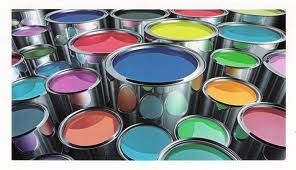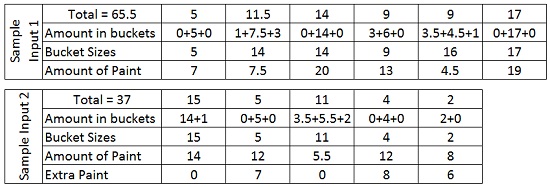Time limit 2000/4000/4000/4000 ms. Memory limit 65000/65000/65000/65000 Kb.
Question by Ibrahim Mesecan.
Paint Buckets
 In a competition for students, students are asked to collect
some paint and fill them into buckets.
Buckets are on a rail system and they can take different amount
of paints. On the rail system they wait certain time and
then, they leave.
The gathered paint at that time can be poured into the active
bucket. If it's full, the half of the extra paint
can be poured to the next and the other half of the extra paint
can be poured to the previous buckets.
If they are also full (or they overflood), the gathered extra
paint is wasted out.
In a competition for students, students are asked to collect
some paint and fill them into buckets.
Buckets are on a rail system and they can take different amount
of paints. On the rail system they wait certain time and
then, they leave.
The gathered paint at that time can be poured into the active
bucket. If it's full, the half of the extra paint
can be poured to the next and the other half of the extra paint
can be poured to the previous buckets.
If they are also full (or they overflood), the gathered extra
paint is wasted out.
Question:
Write a program that is going to first read bucket sizes and
then collected paint amounts.
The program is going to find out the amount of paint
collected by this team.
Note: The first bucket doesn't have the
previous and the last bucket doen't have the next.
Thus, if the first one overfloods to the previous, the
extra paint is wasted.
Input specification
You will be first given an integer number (n) which is
number of buckets where 0 ≤ n ≤ 15000.
Then, you will be given n bucket size in the following
line. The buckets can have sizes
between 1 and 20litters. The following line will have
n floating point numbers, the amount of
paint gathered by students which may vary between 0 and 20.
Output specification
Show a floating point number (with 3 decimal place precision),
the amount of paint gathered bu students.
Sample Input I
6
5 14 14 9 16 17
7 7.5 20 13 4.5 19
|
Sample Input II
5
15 5 11 4 2
14 12 5.5 12 8
|
Sample Output I
65.5 |
Sample Output II
37 |
Explanation:
They always pour the collected paint firstly to
the active bucket. If the bucket is full and there is extra
paint, half of the remaining paint is poured to the bucket
on the right and the other half is poured to the bucket on
the left.
The size of first bucket is 5 liters. And the students
have collected 7 liters. So, they pour 5 liters to the first bucket.
Half of remaining amount (1 liter) is poured to the second
bucket. The capacity of the second bucket is 14 liters. And
students have collected 7.5 liters. So, they can pour all of
it to the second bucket. The capacity of the third bucket is
also 14 liters. And students have collected 20 liters. They
can firstly fill the third bucket (14 liters), then half of the
remaining amount can be poured to the second bucket and the other
half can be poured to the fourth bucket.
Thus, the second bucket has 11.5 liters of paint. (1 liter from
the first bucket, 7.5 liters from the second bucket and 3
liters from the third bucket.)

Для отправки решений необходимо выполнить вход.
|